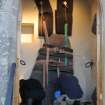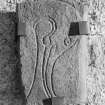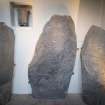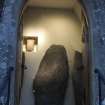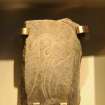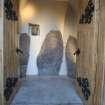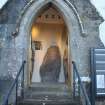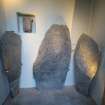Pricing Change
New pricing for orders of material from this site will come into place shortly. Charges for supply of digital images, digitisation on demand, prints and licensing will be altered.
Inveravon
Pictish Symbol Stone (Pictish)
Site Name Inveravon
Classification Pictish Symbol Stone (Pictish)
Alternative Name(s) Inveravon No. 3; Inveraven, Pictish Symbol Stones
Canmore ID 16013
Site Number NJ13NE 7.03
NGR NJ 1828 3757
Datum OSGB36 - NGR
Permalink http://canmore.org.uk/site/16013
- Council Moray
- Parish Inveravon
- Former Region Grampian
- Former District Moray
- Former County Banffshire
A fragment of a Pictish Symbol Stone is attached to the wall of Inveravon Parish Church. Carved onto the stone is the head of a beast, known as the 'elephant' or 'Pictish beast.'
This beast is commonly depicted on Pictish Symbol Stones. It has a long snout, with an antenna emerging from its brow, and ending in a spiral. The tail usually also ends in a spiral.
Text prepared by RCAHMS as part of the Accessing Scotland's Past project
Reference (1903)
NJ13NE 7.03 1828 3757
No. 3, is built into the E wall of the churchyard on the interior. Measuring 0.33m x 0.17m, it has been dressed to form a wall stone. It is made of hard blue gneiss, and is now a fragment of its former size. The only remaining incised decoration is the head of the 'elephant' symbol, facing right.
J R Allen and J Anderson 1903.
Publication Account (1996)
A group of four incised symbol stones found in the kirkyard. They are typical early Pictish stones, being incised on rough, unprepared boulders. Starting at the west, the first bears a crescent (with simple infilling) and V-rod, a triple disc and bar (the 'cauldron symbol') and a mirror and comb. Number 2 is a small fragment of a most graceful beast's head, while no. 3 bears a great disc and rectangle above a fine eagle and a rather rudimentary mirror and comb, all deeply and confidently cut. The last stone has a rather worn crescent and V-rod over a plain beast.
Information from ‘Exploring Scotland’s Heritage: Aberdeen and North-East Scotland’, (1996).
Conservation (December 2011)
Conservation and Relocation
The four Inveravon Class I Incised Pictish Symbol stones, dating from perhaps the 6th-7th Century AD, were set against the south wall of Inveravon Church. The Church is a Category B Listed Building dating from 1806 but sitting on and near the remains of earlier Churches: the earliest existing record of St Peters Church Inveravon dating back to 1108. Found below and adjacent to the present Church, they include representations of the ‘Pictish Beast’, the most iconic and enigmatic of all the Pictish Symbols. The stones are Statutory Monuments. There were problems with the stones being exposed to the freeze thaw cycle in this exposed Highland location. The mounting of the stones was also problematic causing damp ingress to the Church itself through the South Wall.
After consultations with Historic Scotland, Tomintoul Glenlivit & Inveravon Church developed proposals to conserve the Pictish Stones and relocate them in the 1876 North Porch (an early work by the Architect Alexander Marshall Mackenzie).
































